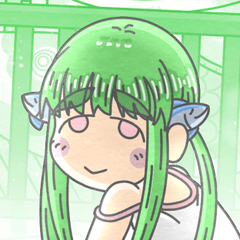Useful Tools When Shading in CSP (regardless of style)
Here's some tools you can use to get from flat colors to having a shaded piece!
Please remember, there are other effects used on this piece (such as effects to the lineart), but for the purpose of the tutorial, I'm only going to be talking about the shading tools.
Note: this is NOT a tutorial on HOW to shade or understanding lighting, but tools in CSP that help you do that.
Each image corresponds to the text above it. Here's the example of the finished result.
So, of course, when you begin, you've laid out your flat colors. From this point, you're trying to shade.
Apologies for the image quality--I recently lost all of my work files and this is a picture of a recording of the piece.
The first useful tool in CSP is learning how to use clipping layers. I'll explain the difference between clipping and simply using another layer for shading.
Anyhow, on top of your flat color layer, create a new raster layer by selecting the icon shown below under the "Layer" settings.
Now, make it a clipping layer.
The difference between using a clipping layer and using a regular layer:
First, the clipping layer keeps the opacity of the layer it's clipped to. This is like locking your original layer and shading on it, but you can remove all effects if you don't like it.
The other reason you'll use a clipping layer is so that when you use effects, they add to the original flat colors instead of editing it all. This will be clearer in the next steps.
Now, put the clipping layer on "Multiply".
What this does is when you select your original flat color and use it with the "Multiply" effect, it will automatically darken and saturate your color. This prevents the issue of your shading looking too grey (for artists that simply make the color darker in value and not change the hue or saturation).
If you are looking to render the piece, merge the clipping layer and the original flat colors together. It will keep the integrity of both layers, and you will have a nice, saturated shadow color you can now blend!
Of course, keep in mind that this is the most basic way of using the tool. The clipping layer and "Multiply" effect can be used many different ways, even when painting realistically.
Here is the image after using the "Multiply" shading.
























Comment